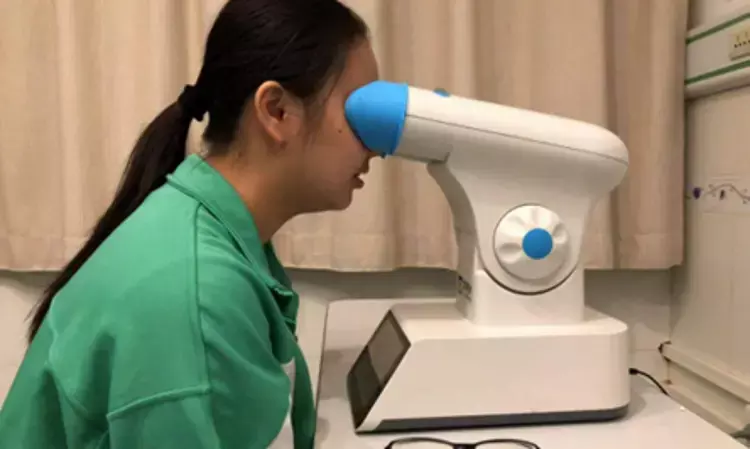- Home
- Medical news & Guidelines
- Anesthesiology
- Cardiology and CTVS
- Critical Care
- Dentistry
- Dermatology
- Diabetes and Endocrinology
- ENT
- Gastroenterology
- Medicine
- Nephrology
- Neurology
- Obstretics-Gynaecology
- Oncology
- Ophthalmology
- Orthopaedics
- Pediatrics-Neonatology
- Psychiatry
- Pulmonology
- Radiology
- Surgery
- Urology
- Laboratory Medicine
- Diet
- Nursing
- Paramedical
- Physiotherapy
- Health news
- Fact Check
- Bone Health Fact Check
- Brain Health Fact Check
- Cancer Related Fact Check
- Child Care Fact Check
- Dental and oral health fact check
- Diabetes and metabolic health fact check
- Diet and Nutrition Fact Check
- Eye and ENT Care Fact Check
- Fitness fact check
- Gut health fact check
- Heart health fact check
- Kidney health fact check
- Medical education fact check
- Men's health fact check
- Respiratory fact check
- Skin and hair care fact check
- Vaccine and Immunization fact check
- Women's health fact check
- AYUSH
- State News
- Andaman and Nicobar Islands
- Andhra Pradesh
- Arunachal Pradesh
- Assam
- Bihar
- Chandigarh
- Chattisgarh
- Dadra and Nagar Haveli
- Daman and Diu
- Delhi
- Goa
- Gujarat
- Haryana
- Himachal Pradesh
- Jammu & Kashmir
- Jharkhand
- Karnataka
- Kerala
- Ladakh
- Lakshadweep
- Madhya Pradesh
- Maharashtra
- Manipur
- Meghalaya
- Mizoram
- Nagaland
- Odisha
- Puducherry
- Punjab
- Rajasthan
- Sikkim
- Tamil Nadu
- Telangana
- Tripura
- Uttar Pradesh
- Uttrakhand
- West Bengal
- Medical Education
- Industry
Repeated low-level red light exposure may improve myopia among children: Study

Repeated low-level red light exhibited a stronger impact on myopic children compared with premyopic individuals suggests a study published in the British Journal of Ophthalmology.
A study was done to compare the effects of repeated low-level red light (RLRL) treatment on axial length growth and refractive error changes in myopic and premyopic children. Subjects were assigned randomly to four subgroups: myopia-repeated low-level red light group (M-RL), myopia-control group (M-C), premyopia-repeated low-level red light group (PM-RL) and premyopia-control group (PM-C). Subjects in the RLRL group completed a 12-month treatment composed of a 3 min repeated low-level red light treatment session twice daily, with an interval of at least 4 hours, for 7 days per week. Visits were scheduled before and at 1-month, 3-month, 6-month, 9-month and 12-month follow-up after the treatment.
Repeated-measures analysis of variance was used to compare the spherical equivalent refractive errors (SE) and axial length (AL) changes between the groups across the treatment period.Results: After 12 months of treatment, in the myopia group, SE and AL changes were −0.078±0.375 D and 0.033±0.123 mm for M-RL and −0.861±0.556 D and 0.415±0.171 mm for M-C; in the premyopia group, the progression of SE and AL was −0.181±0.417 D and 0.145±0.175 mm for PM-RL and −0.521±0.436 D and 0.292±0.128 mm for PM-C. PM-RL indicated a lower myopia incidence than PM-C (2.5% vs 19.4%). Additionally, the percentage of AL shortening in the M-RL was higher than that in the PM-RL before the 9-month follow-up. Repeated low-level red light effectively delayed myopia progression in children with myopia and reduced the incidence of myopia in premyopic children. Moreover, repeated low-level red light exhibited a stronger impact on myopic children compared with premyopic individuals.
Liu G, Rong H, Liu Y, et alEffectiveness of repeated low-level red light in myopia prevention and myopia control. British Journal of Ophthalmology. Published Online First: 17 April 2024. doi: 10.1136/bjo-2023-324260
Dr. Shravani Dali has completed her BDS from Pravara institute of medical sciences, loni. Following which she extensively worked in the healthcare sector for 2+ years. She has been actively involved in writing blogs in field of health and wellness. Currently she is pursuing her Masters of public health-health administration from Tata institute of social sciences. She can be contacted at editorial@medicaldialogues.in.
Dr Kamal Kant Kohli-MBBS, DTCD- a chest specialist with more than 30 years of practice and a flair for writing clinical articles, Dr Kamal Kant Kohli joined Medical Dialogues as a Chief Editor of Medical News. Besides writing articles, as an editor, he proofreads and verifies all the medical content published on Medical Dialogues including those coming from journals, studies,medical conferences,guidelines etc. Email: drkohli@medicaldialogues.in. Contact no. 011-43720751


